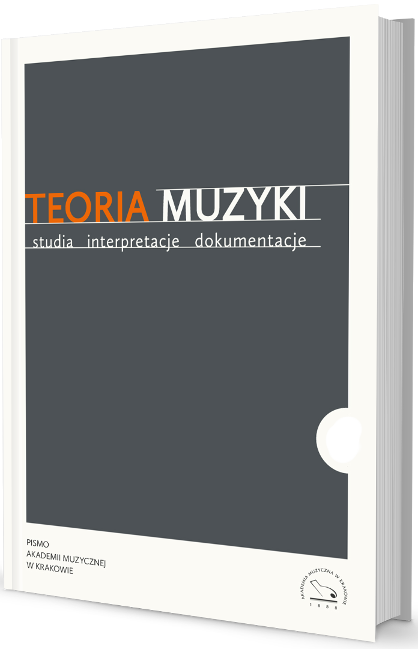„Pokolenie 33” na przełomie tysiącleci. Między sonoryzmem,
nowym romantyzmem i postmodernizmem
„The Generation of 33” at the Millennium Threshold.
Between Sonorism, New Romanticism and Postmodernism
Author(s): Leszek PolonySubject(s): Music
Published by: Akademia Muzyczna w Krakowie im. Krzysztofa Pendereckiego
Summary/Abstract: “The generation of 33” in the Polish music of the turn of the two millennia was born as an artistic entity in the wake of the Polish October 1956. It is inseparable from the term “the Polish compositional school” and from the sonorist universe of aggressive clusters, noise, unconventional effects of sound. This universe of new tonality all but overthrew its avant-garde predecessor: abstract and constructivist dodecaphonic serialism. Yet it only lasted for little more than a decade. Its evolution was marked by a gradual retreat from radicalism of sound. The breakthrough was heralded, in Górecki, by his Ad Matrem as early as in 1971, which ushered the composer into his phase of sacred music. For Penderecki, the same can be said of his Awakening of Jacob (1974) not only because of its symbolic message but also due to symptoms of reverting to specific procesual narrative, based on melodic-harmonic evolution. For Kilar, born in 1932, his Krzesany (1974) brought a renaissance of vital folklorism in a modal-sonorist harmonic medium. Still, the true breakthrough happened in the memorable years 1976-1977 with Górecki’s Third Symphony, Penderecki’s First Violin Concerto, Kilar’s Kościelec 1909, Bujarski’s Musica domestica; these compositions have been since hailed by music criticism and the later monographer of the trend, Paweł Strzelecki, as representative for the merging “New Romanticism.” The breakthrough coincided precisely with the advent of a new generation of composers, subsequently termed “the Stalowa Wola generation” or the “Generation of 51.” And this is how this remarkable association and alliance of the two generations came to be.It seems quite reasonable – from the perspective of almost forty years now – to discuss the validity and the legitimacy of the term “New Romanticism” as a trend in the music of the turn of the millennia, American or European or any other as well as Polish. It must be remembered that this would constitute a third “new romanticism” since the Neoromanticism of the late 19 th century and the fin-de-siècle , the later Liszt and Wagner, Hugo Wolf, Richard Strauss and Gustav Mahler. It is worthwhile to remember, too, the significant essay by Konstanty Regamey on Karol Szymanowski of 1938. Regamey diagnosed “a modernist romanticism” not only in the middle oeuvre of the composer, but also in his later music, that of his so-called “national” period. He saw its essence in Szymanowski’s general aesthetic position: in the “poetic nature” and the subjective emotionality of his music, in the composer’s conviction of the supra-historicality of art, itself a metaphysical “sublimation of message expressed.” Regamey held that Szymanowski’s Stabat Mater as a quintessence of this understanding of “New Romanticism.” The term itself of “New Romanticism” obviously carries the risk of a narrow interpretation of music in neostylistic “retro” aesthetics. The fundamental question arises of the relationship between New Romanticism and Postmodernism. Criticism that accompanied New Romanticism was first dominated by a contrast between the two tendencies and a very harsh critique of the latter. Postmodernism was accused of relativism, manipulation of tradition, supremacy of shallow aesthetic play over striving towards truth. A new outlook on this appeared in younger authors in the nineties.Jann Pasler, the author of the Postmodernism entry in The New Grove Dictionary of Music and Musicians differentiates between three basic kinds of Postmodernism: 1. a postmodernism of connection and interpenetration, 2. a postmodernism of resistance, and 3. a postmodernism of reaction. The last of these denotes a return to the previously-rejected categories (tonality, euphony, traditional narrativity, and to fundamental qualities beyond music such as religious spirituality or mysticism). This return is characteristic in its serio attitude (cf. N. Szwab, 2013).In this perspective, the primary antagonism of New Romanticism and Postmodernism seems to dissolve in the broader context of postmodernity, the general spiritual orientation of our time. The cyclical recurrence of romanticism in the highly antiromantic 20 th century are a significant phenomenon. This aesthetics not only does not fade away in the composers seen as 20 th -century posthumous children of romanticism such as Richard Strauss, Sergei Rachmaninoff or Jean Sibelius; it is reborn or indeed it flourishes in ever-novel medium of music.
Journal: Teoria Muzyki. Studia, Interpretacje, Dokumentacje
- Issue Year: II/2013
- Issue No: 3
- Page Range: 33-44
- Page Count: 12
- Language: Polish

